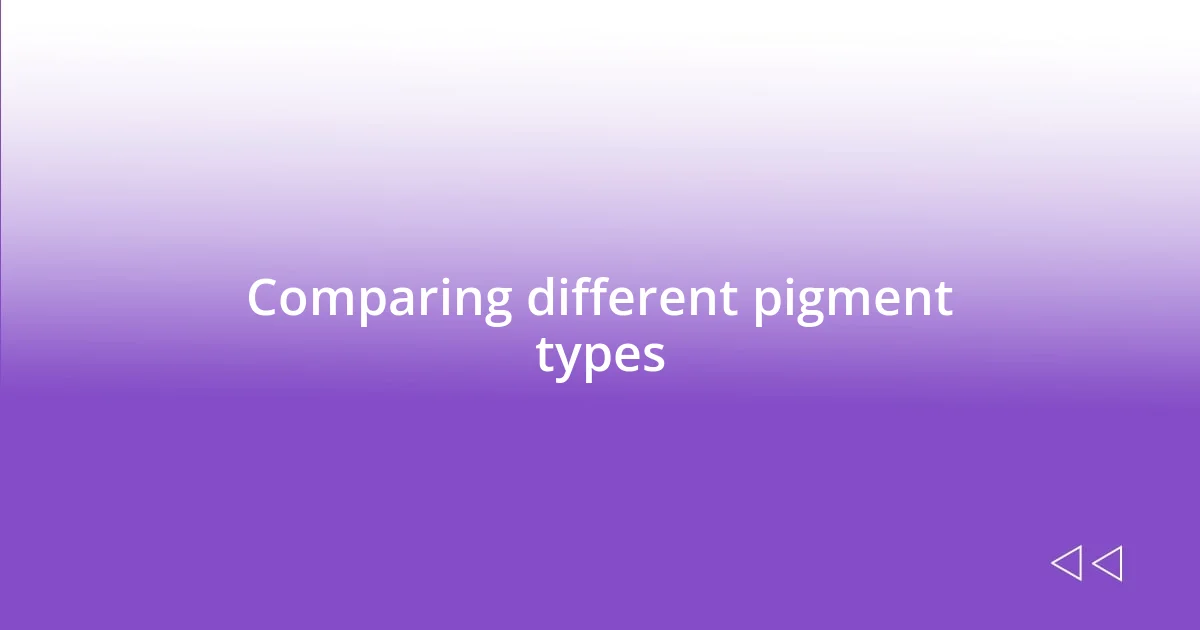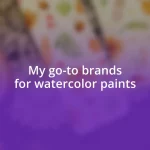Key takeaways:
- Quality pigments can significantly enhance the vibrancy and emotional depth of artwork, influencing the overall artistic experience.
- Top brands like Winsor & Newton, Daniel Smith, and Sennelier are highlighted for their unique features, such as excellent transparency, creamy texture, and innovative formulations.
- Choosing the right pigment brand involves considering the project’s needs, the texture of the paint, and community recommendations to enhance creativity and expression.

Introduction to pigment brands
When I first ventured into the world of art supplies, I was overwhelmed by the sheer number of pigment brands available. Each one seemed to have its own unique personality, much like the artists who use them. Have you ever wondered how something as simple as a color can inspire a piece of artwork?
As I began experimenting with different pigments, I quickly learned that the quality can vary significantly between brands. For instance, certain brands consistently deliver vibrant hues that make my artwork pop, while others tend to be dull and lackluster. Isn’t it fascinating how the right pigment can transform not just the color, but the entire feel of an artwork?
Let’s not forget the emotional connection we often have with specific pigments. There are days when a rich, warm ochre reminds me of the sun-soaked landscapes of my childhood. In a way, those brands don’t just create colors; they evoke memories and feelings that are deeply intertwined with my artistic journey.

Top quality pigment brands
When it comes to top-quality pigment brands, I’ve always gravitated toward a few that never fail to impress me. One of my favorites, for example, is Winsor & Newton. Their watercolors have an unrivaled brightness that breathes life into my landscapes, reminding me why I fell in love with painting in the first place. Their pigments are not just colors; they’re a bridge to better artwork, capturing the elation of a sunset or the serenity of a forest scene.
Here’s a list of some top brands that I’ve found consistent in quality and performance over the years:
- Winsor & Newton: Known for their rich colors and excellent transparency.
- Daniel Smith: Their range includes unique pigments that inspire creativity and exploration.
- Sennelier: A favorite among oil painters for their creamy texture and vivid hues.
- M. Graham: Their pigments maintain excellent vibrancy due to the use of honey in their formulation.
- Schmincke: Offers professional-grade watercolors that blend beautifully and provide excellent lightfastness.
As I think back on my artistic explorations, it’s brands like these that have helped me grow, offering not just pigments, but a foundation of color that allows my imagination to flourish. Each tube or jar holds the potential for a new adventure, and that feeling never gets old.

Comparing different pigment types
When comparing different pigment types, it’s essential to understand that not all pigments are created equal. For instance, I’ve noticed that synthetic pigments often offer incredible consistency across batches, which is vital when I’m working on a commissioned piece. On the other hand, natural pigments can bring an earthy quality to my work that synthetic options sometimes struggle to replicate. Does the quality of the pigment really affect the final artwork? In my experience, absolutely; the right choice can elevate a piece from ordinary to extraordinary.
Additionally, the medium in which pigments are used plays a crucial role in their performance. I remember the first time I used watercolor pigments from Daniel Smith; their transparency allowed my layered washes to sing with an unexpected vibrancy. In contrast, when I transitioned to oil paints with Sennelier, the creamy texture added depth in ways I hadn’t anticipated. This variability often reflects the unique characteristics of the pigments themselves and how they interact with the chosen medium.
In my artistic journey, I’ve come to value pigments that not only perform but also inspire. For instance, the rich umbers from M. Graham have an almost nostalgic feel for me, reminiscent of the Renaissance masters I admired as a child. They bring a certain historical gravitas to my work that makes each brushstroke feel like a conversation with the past. So, when considering different pigment types, think about how each one resonates with your style and the emotions you wish to convey.
| Pigment Type | Characteristics |
|---|---|
| Synthetic | Consistent color, vibrant hues, high lightfastness |
| Natural | Earthy tones, unique textures, varied transparency |

Popular pigment brands overview
When it comes to popular pigment brands, I often think about the diversity they bring to my creative process. For instance, my first serious encounter with oil paints was through Rembrandt, which left a lasting impression on me. Their pigments have a depth that seems to invite you to push the boundaries of your artistic expression. Have you ever felt that pull of a color tempting you to experiment? It’s a thrilling experience that these brands can inspire.
Another brand that stands out in my mind is Holbein. Their rich vibrancy captivated me from day one; the moment I squeezed out their acrylics, I knew I was in for something exceptional. I vividly remember the excitement of mixing their vivid primary hues, which opened up a world of possibilities on my canvas. It made me appreciate how the right brand can transform not just the artwork but the entire creative process.
Lastly, I can’t help but reflect on the impact of golden acrylics. When I first tried them, I was bowled over by the smooth application and intense luminosity. It’s amazing how different pigments can capture and manipulate light. I recall working on a piece that portrayed sunlight filtering through leaves; the golden acrylics perfectly articulated that glowing effect. Brands like these truly make a difference, elevating the passion I pour into every piece I create.

Features of leading pigment brands
Leading pigment brands often showcase distinctive features that resonate deeply with artists. For example, I’ve always been impressed by how certain brands, like Winsor & Newton, provide an expansive range of colors that allows for incredible versatility in my work. Have you ever experimented with a color palette so rich that it seemed to spark endless ideas? That’s the magic of a brand that truly understands its artists.
I’ve noticed that another defining characteristic of top pigment brands is their commitment to lightfastness—the ability of pigments to resist fading over time. When I worked with Schmincke, I was fascinated by how their pigments maintained vibrancy even under challenging lighting conditions. This durability gives me peace of mind, knowing that my creations will stand the test of time. It forces me to ask: what good is a beautiful piece if it can’t be appreciated later?
Moreover, user-friendly packaging and the consistency of color across different mediums can’t be overlooked. I remember my first experience with Liquitex acrylics; their easy-to-squeeze tubes were a revelation. It made my workflow smoother, allowing me to focus on my creativity rather than struggling with cumbersome materials. Don’t you think that the right packaging can enhance your artistic experience just as much as the pigment itself?

How to choose pigment brands
Choosing the right pigment brand can significantly influence your artistic journey. Personally, I often recommend considering the specific projects you’ll be working on. For instance, if you’re creating a vibrant landscape, brands known for their intense, luminous colors, like Holbein, might be your go-to. What kind of projects inspire you, and what do you need from your pigments to bring them to life?
Another important factor is the texture of the paint. I remember the first time I tried a heavy-bodied acrylic; it felt like my brush was dancing across the canvas, giving me an unexpected level of control and expression. Experimenting with different textures can dramatically affect your work’s final appearance. Have you ever felt that brush movement change your whole approach to a piece?
Lastly, don’t overlook the importance of reviews and recommendations from fellow artists. In my early days, seeking advice on pigment brands opened doors I didn’t even know existed. Building a relationship with your favorite art suppliers can help you discover hidden gems. Which brands have drawn you in, and what feedback have you gathered from the community?

Using pigments in art projects
Using pigments in art projects can bring out an artist’s inner vision in wonderful ways. I remember when I first learned how to mix pigments; the thrill of creating custom colors was exhilarating. There’s something profoundly satisfying about seeing an original hue develop right before your eyes. Have you ever mixed colors only to discover a beautiful shade that complements your artwork perfectly?
When I work on detailed pieces, I find that certain pigments allow for incredible layering, which adds depth and texture. For example, while painting a series of portraits, I turned to transparent pigments that let my underpainting shine through. This technique gave my work a luminescence I hadn’t anticipated. Don’t you agree that those little surprises in your process can inspire fresh creativity?
Also, the feeling of using high-quality pigments is like an invitation to dive deeper into your artistic expression. I can recall a project where I used a specialized set of metallic pigments; the shimmer added a whole new dimension to my work, making it mesmerize viewers. How does the material you choose influence the emotion you want to convey through your art? It’s fascinating how the right pigments can transform a simple piece into something truly captivating.














